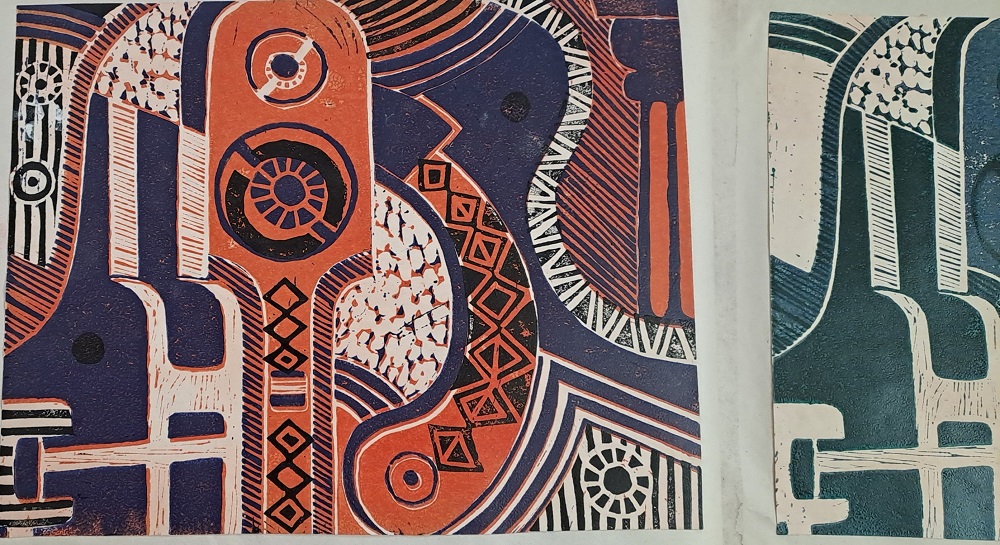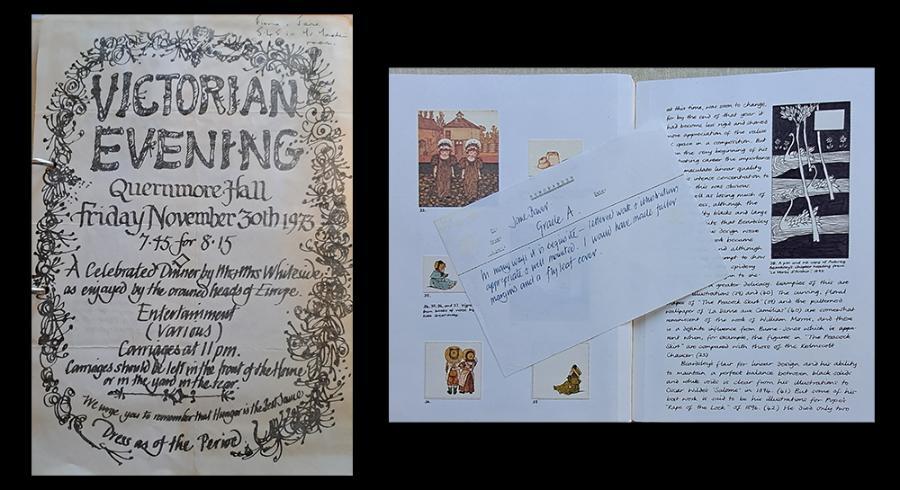
A response to the news of the death of my tutor Ben Holgate, aged 98
In July 1973, I left my all-girls’ grammar school, where art, my main subject, consisted of drawing objects in pencil, painting flowers and and learning about the old masters in large books from quiet female teachers. Two months later, I was at the freshers’ ball at S. Martin’s, which was held in the Princess Margherita Hall. A few yards away an older, sweating male figure gyrated, shirt open and tie bound around his head. ‘Who’s THAT?’ I asked someone. ‘Oh, that’s the art tutor, Barry Gregson’ came the reply.
That art department was just inside the back gate of S. Martin’s, and I can smell the oil and turpentine mix of it now, see – and hear - its dark, worn wooden floorboards, and feel the wood surrounds of its entrance door, fingerprinted with countless oil-painted hands, though I never painted – I would walk through to the right, and enter the clay studio with its different, damp scent. I had chosen to specialise in ceramics, taught, in his own memorable style, by Barry Gregson.
But there was another highly gifted ceramicist in the team at the time. Far more reserved than the off-the-wall Barry, Head of the Art Department Ben Holgate had been the tutor I had first met at my interview for a college place, on 1 November 1972. (My teenage diary records ‘Interview good on the art side. College GORGEOUS – nice friendly people.’)
Ben had a thick thatch of dark grey hair, wore dark cotton shirts and woven wool ties in pleasing colours and textures, and approached unobtrusively if one was working on a piece. He and I shared a love of small detail and decoration. He understood what I was trying to do, and I loved his ceramic pieces of doves with fanned tails, Vikings with studded shields and curly beards, and stylised figures based on cone shapes. I always valued talking with him, his opinions and suggestions.

Ben would listen as much as he spoke, watch, question, challenge and smile. He once used the phrase ‘daft as a ha’penny watch’ (in reference to what, I forget, but hopefully not me) which amused me. He had a casually beautiful Italic handwriting, and I still have the invitation he designed for a Victorian evening (pic 1) at which my room-mate Fiona Plane and I were serving girls in mob caps, and his comment in my very first art assignment on Victorian children’s book illustration (pic 2). All assignments were of course hand-written, as were the tutors’ remarks. Ben taught us about Victorian cast ironwork and took us on a coach trip to Liverpool Art Gallery. Long after I had left college, I discovered and fell in love with his paintings, one of which, owned by a friend in Lancaster, depicted a breeze-blown, sun-warmed cornfield. I would gaze at it with undisguised envy.
My friend and contemporary Diane Sammons (nee Lewis) says, ‘My recollections of Ben are of a man I liked and respected, and he was the main reason I named my firstborn Ben.
I remember his lovely, glazed men in a boat, and his lovely cornfield and poppy field painting… glorious! ‘
Alan Revill, who did art as his main subject at S. Martin’s (1968-71) writes: ‘My look was jeans, tie dye and beard in those Holgate years, and although I never did ceramics under Ben, he instilled a freedom into the department and a sense of excellence in the work and in its striving. I could work long hours on a painting (taught by Jan Thorn) or printing, sometimes right through the night. My second main subject, geography, got me out to the potteries, N. Ireland, the Welsh steel mills and the new towns of Scotland. Altogether, with a teaching practice in Oban, I was a Happy lad – and Ben’s fine art department had a large part to play in that.’

It was a pleasure to work with all four of my art tutors, each of whom taught me for parts of my three year teacher training and my one year B.Ed course. The other two were Ray Haslam and Jan Thorn, for both of whose families, after a time, I occasionally babysat. Ray wore leather jackets or leather elbow patches, had wavy red-gold hair and a mild manner. I was once carving a lino block (I still have the print I made from it – pic 3) with an extremely sharp tool, which I was directing, wrongly, towards my own left wrist. I was suddenly aware of a presence at my shoulder. ‘You see that little vein in your wrist that’s full of blood?’ said Ray pleasantly. ‘That tool is heading straight for it. I’d always point it away from you if I were you.’ He walked calmly away.
Jan had a cherry-red face, fine, fly-away dark hair, and a distinctive rolling walk in his dark brown Polyveldts shoes. He possessed a plain, tailored jacket in bright jade green. He had a northern voice and a rather slow delivery with a hint of humour in it. My father, Len Bower, had trained Jan and his wife Sue at Leeds College of Art, and I could recognise my father’s approach in Jan’s teaching.
Barry was a different kettle of fish, with an earthy, gritty voice, huge hands and a passion and affinity with clay which he passed on to me in spades. His approach could appear somewhat alarming. On day one, he gave us each a vast chunk of wet clay and told us to do anything we liked to it. ‘Shove holes in it! Tunnel it! Tear it! Slap it!’ he yelled, as we tentatively obeyed. To our consternation he then led us away and blindfolded us, then brought us back into the clay studio, where he had switched all our creations around, and shouted ‘Right – find your piece!’ I continued to use his ideas throughout my 40 year art teaching career, introducing thousands of children and teachers in over 400 primary schools to the miracle of clay, albeit in a somewhat gentler style.

We were encouraged to keep an art diary, spanning all four years. Mine is crammed, and shows the development of my thinking. Ben related strongly to my final B.Ed assessment choice, as it focused on minute decorative detail. I studied sweets and their packaging. Pic 4 shows my art diary with the fruits of my labours – packaging hand-made and hand-painted, and all sweets made, from plaster and plastic, to resemble the real thing. I also made a chess set of sweets (pic 5) from white and chocolate porcelain clay – it now lives in my understair cupboard!

I was amused to find in my art diary two cartoons I had drawn when pondering statues – a totem pole featuring Jan, Ray and Barry (pic 6) and one of Barry alone (pic 7).
The threesome, I gather, comprised a skiffle group, singing and playing locally. Ray was a gifted guitarist. But for one of the annual staff and student shows, again in the PM Hall, they performed a truly superb turn. On stage, they had built a set of three plain white toilet cubicles. Each man came in separately and disappeared into a cubicle. For a moment we dreaded what they might be about to do, but each had a large pot of paint and began to daub the back wall of their own cubicle – they could not, of course, see the other two. Gradually the student audience began to scream with laughter as the figure of a naked woman became apparent, spanning all three cubicles.
Ben was not part of these shenanigans, though I am sure he viewed them with a quiet smile, the sage observer of his colleagues’ Goodies-style antics. How many hours of my free time I spent in the clay studio, I have no idea – yet, regrettably, I find I do not have a single photograph of it. Nor did I see any of my tutors after I had left – apart from one. In 2008 I was queuing in a Lancaster post office during a new year stay. Suddenly I recognised, from the front of the queue, the unique tones of Jan Thorn. ‘Jan!’ I said, assuming he would look blankly at me. Instead he beamed - ‘What are YOU doing here?’ and invited me back to his house, where his walls held artwork by his former colleagues. To my horror he told me that Barry’s daughter, the sculptor Judith Gregson, former wife of artist Andy Goldsworthy, had been killed in a car crash a few days earlier.
Looking back, I realise how very, very fortunate I was to be guided, taught and cared for by these four very remarkable personalities, and how their tuition, knowledge and approach has influenced my own career. Jan and Ben have gone; I do not know if Ray and Barry are still with us. If so, and they are reading this – a sincere thank you.
Jane Bower, class of 1977, Primary Education
